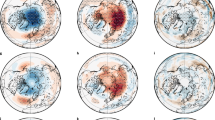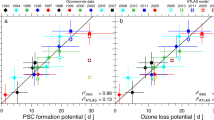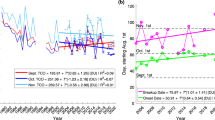Abstract
The reduction in the amount of ozone in the atmospheric column over the Arctic region, observed during the 1990s1,2, resembles the onset of the Antarctic ozone ‘hole’ in the mid-1980s, but the two polar regions differ significantly with respect to the relative contributions of chemistry and atmospheric dynamics to the ozone abundance. In the strong, cold Antarctic vortex, rapid springtime chemical ozone loss occurs throughout a large region of the lower stratosphere, whereas in the Arctic, although chemical ozone depletion has been observed3,4,5,6,7,8,9,10,11, the vortex is generally much smaller, weaker and more variable12. Here we report a model-based analysis of the relative importance of dynamics and chemistry in causing the Arctic ozone trend in the 1990s, using a state-of-the-art three-dimensional stratospheric chemistry–transport model. North of 63°?N we find that, on average, dynamical variations dominate the interannual variability, with little evidence for a trend towards more wintertime chemical depletion. However, increases in the burden of atmospheric halogens since the early 1970s are responsible for a large (14%) reduction in the average March column ozone, but this effect is mostly caused by increased destruction throughout the year rather than by halogen chemistry associated with wintertime polar statospheric clouds. Any influence of climate change on future average Arctic ozone amounts may thus be dominated by possible circulation changes, rather than by changes in chemical loss.
This is a preview of subscription content, access via your institution
Access options
Subscribe to this journal
Receive 51 print issues and online access
$199.00 per year
only $3.90 per issue
Buy this article
- Purchase on Springer Link
- Instant access to full article PDF
Prices may be subject to local taxes which are calculated during checkout




Similar content being viewed by others
References
Newman, P. A. et al. Anomalously low ozone over the Arctic. Geophys. Res. Lett. 24, 2689–2692 (1997).
Fioletov, V. E. et al. Long-term ozone decline over the Canadian Arctic to early 1997 from ground-based and balloon observations. Geophys. Res. Lett. 24, 2705–2708 (1997).
Rex, M. et al. Prolonged stratospheric ozone loss in the 1995–96 Arctic winter. Nature 389, 835–838 (1997).
Müller, R. et al. Chlorine activation and ozone depletion in the Arctic vortex: Observations by the Halogen Occultation Experiment on the Upper Atmosphere Research Satellite. J. Geophys. Res. 101, 12531–12554 (1996).
Müller, R. et al. Severe chemical ozone loss in the Arctic during the winter 1995–96. Nature 389, 709–712 (1997).
Müller, R. et al. HALOE observations of the vertical structure of chemical ozone depletion in the Arctic vortex during winter and early spring 1996–1997. Geophys. Res. Lett. 24, 2717–2720 (1997).
Manney, G. L. et al. Arctic ozone depletion observed by UARS MLS during the 1994–95 winter. Geophys. Res. Lett. 23, 85–88 (1996).
Manney, G. L., Santee, M. L., Froidevaux, L., Waters, J. W. & Zurek, R. W. Polar vortex conditions during the 1995–96 Arctic winter: Meteorology and MLS ozone. Geophys. Res. Lett. 23, 3203–3206 (1996).
Manney, G. L., Froidevaux, L., Santee, M. L., Zurek, R. W. & Waters, J. W. MLS observations of Arctic ozone loss in 1996–97. Geophys. Res. Lett. 24, 2697–2700 (1997).
Sinnhuber, B. M., Langer, S., Klein, U., Raffalski, U. & Kunzi, K. Ground based millimeter-wave observations of Arctic ozone depletion during winter and spring of 1996/97. Geophys. Res. Lett. 25, 3327–3330 (1997).
Hansen, G., Svenøe, T., Chipperfield, M. P., Dahlback, A. & Hoppe, U. P. Evidence of substantial ozone depletion in winter 1995/96 over northern Norway. Geophys. Res. Lett. 24, 799–802 (1997).
Zurek, R. W., Manney, G. L., Miller, A. J., Gelman, M. E. & Nagatani, R. M. Interannual variability of the north polar vortex in the lower stratosphere during the UARS mission. Geophys. Res. Lett. 23, 289–292 (1996).
Dobson, G. M. B. Observations of the amount of ozone in the earth's atmosphere and its relation to other geophysical conditions. Proc. R. Soc. Lond. A 129, 411–433 (1930).
Hood, L. L., McCormack, J. P. & Labitzke, K. An investigation of dynamical contributions to midlatitude ozone trends in winter. J. Geophys. Res. 102, 13079–13093 (1997).
Steinbrecht, W., Claude, H., Kohler, U. & Hoinka, K. P. Correlations between tropopause height and total ozone: Implications for long-term changes. J. Geophys. Res. 103, 19183–19192 (1998).
Rood, R. B., Allen, D. J., Baker, W. E., Lamich, D. J. & Kaye, J. A. The use of assimilated stratospheric data in constituent transport calculations. J. Atmos. Sci. 46, 687–701 (1989).
Lefèvre, F., Brasseur, G. P., Folkins, I., Smith, A. K. & Simon, P. Chemistry of the 1991–1992 stratospheric winter: Three-dimensional model simulations. J. Geophys. Res. 99, 8183–8195 (1994).
Chipperfield, M. P. et al. Analysis of UARS data in the southern polar vortex in September 1992 using a chemical transport model. J. Geophys. Res. 101, 18861–18881 (1996).
Chipperfield, M. P. Multiannual simulations with a 3D chemical transport model. J. Geophys. Res. 104, 1781–1805 (1999).
Swinbank, R. & O'Neill, A. Astratosphere-troposphere data assimilation system. Mon. Weath. Rev. 122, 686–702 (1994).
Lefèvre, F., Figarol, F., Carslaw, K. S. & Peter, T. The 1997 Arctic ozone depletion quantified from three-dimensional model simulations. Geophys. Res. Lett. 25, 2425–2428 (1998).
Becker, G., Müller, R., McKenna, D. S., Rex, M. & Carslaw, K. S. Ozone loss rates in the Arctic stratosphere in the winter 1991/1992: Model calculations compared with Match results. Geophys. Res. Lett. 25, 4325–4329 (1998).
World Meteorological Organization Scientific Assessment of Ozone Depletion: 1994 (Rep. No. 7, Global Ozone Researchand Monitoring Projec, Geneva, Global Ozone Researchand Monitoring Projec (1995).
Shindell, D. T., Rind, D. & Lonergan, P. Increased polar stratospheric ozone losses and delayed eventual recovery owing to increasing greenhouse-gas concentrations. Nature 392, 589–592 (1998).
Acknowledgements
We thank P. Newman for information about the 1998 TOMS data, H. Teyssèdre for TOMS calculations, and J. A. Pyle for help and support. This work was supported by the UK Natural Environment Research Council.
Author information
Authors and Affiliations
Corresponding author
Rights and permissions
About this article
Cite this article
Chipperfield, M., Jones, R. Relative influences of atmospheric chemistry and transport on Arctic ozone trends. Nature 400, 551–554 (1999). https://doi.org/10.1038/22999
Received:
Accepted:
Issue Date:
DOI: https://doi.org/10.1038/22999
This article is cited by
-
Dynamical mechanisms for the recent ozone depletion in the Arctic stratosphere linked to North Pacific sea surface temperatures
Climate Dynamics (2022)
-
Delay in recovery of the Antarctic ozone hole from unexpected CFC-11 emissions
Nature Communications (2019)
-
Quantifying Arctic lower stratospheric ozone sources in winter and spring
Scientific Reports (2018)
-
The search for signs of recovery of the ozone layer
Nature (2006)
-
Fast Ozone Loss Around the Polar Vortex During 2002/2003 Arctic Winter Deep Minihole Event
Water, Air, & Soil Pollution (2006)
Comments
By submitting a comment you agree to abide by our Terms and Community Guidelines. If you find something abusive or that does not comply with our terms or guidelines please flag it as inappropriate.



